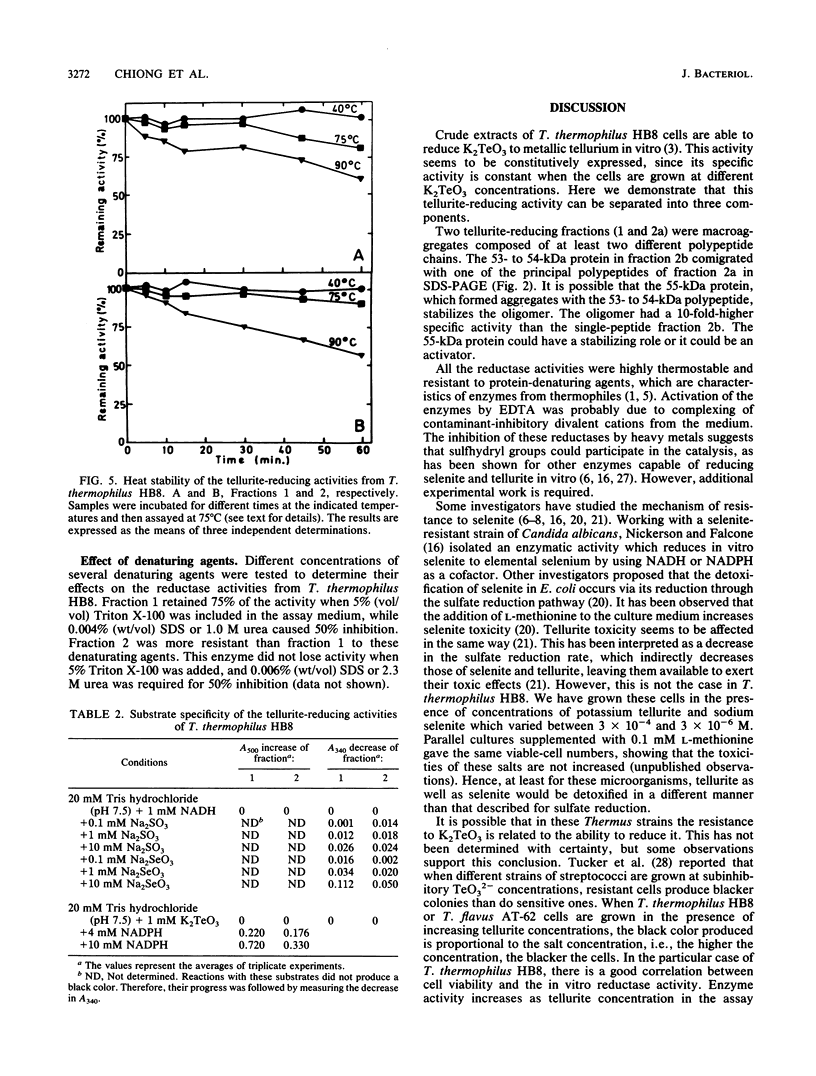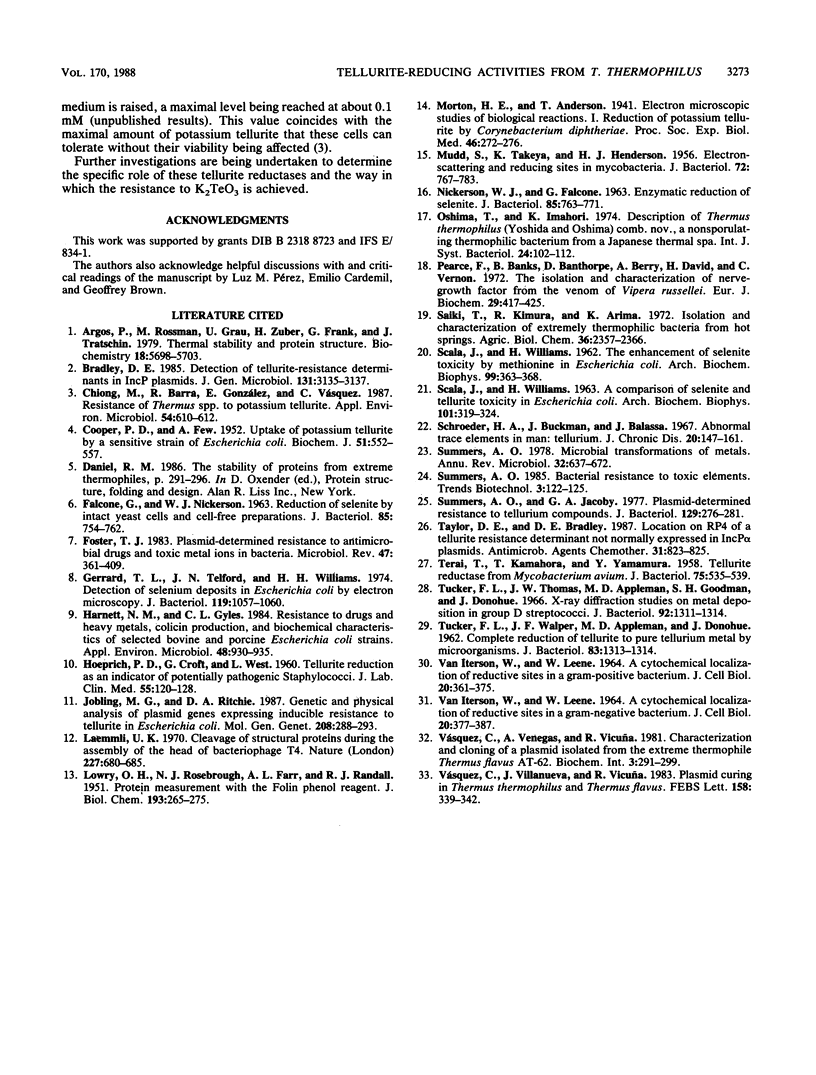Abstract
Cell-free extracts of Thermus thermophilus HB8 catalyze the in vitro, NADH-dependent reduction of potassium tellurite (K2TeO3). Three different protein fractions with tellurite-reducing activities were identified. Two exhibited high molecular weight and were composed of at least two different polypeptides. The protein in the third fraction was purified to homogeneity and had a single polypeptide chain of 53 to 54 kilodaltons, with an isoelectric point of 8.1. Each enzyme was thermostable, the temperature optimum was 75 degrees C, and 30 mM NaCl, 1.5 M urea, or 0.004% sodium dodecyl sulfate caused 50% inhibition of the enzymes. However, 2% Triton X-100 did not have an inhibitory effect. The enzymes were also able to catalyze the reduction of sodium selenite and sodium sulfite in vitro. NADH was replaceable by NADPH. Divalent cations, such as Ca2+ and Ba2+, had no effect on the activity, while similar concentrations of Zn2+, Ni2+, and Cu2+ abolished the activity. This reductase activity could enable these bacteria both to reduce K2TeO3 and to increase their tolerance toward this salt.
Full text
PDF




Images in this article
Selected References
These references are in PubMed. This may not be the complete list of references from this article.
- Argos P., Rossman M. G., Grau U. M., Zuber H., Frank G., Tratschin J. D. Thermal stability and protein structure. Biochemistry. 1979 Dec 11;18(25):5698–5703. doi: 10.1021/bi00592a028. [DOI] [PubMed] [Google Scholar]
- Bradley D. E. Detection of tellurite-resistance determinants in IncP plasmids. J Gen Microbiol. 1985 Nov;131(11):3135–3137. doi: 10.1099/00221287-131-11-3135. [DOI] [PubMed] [Google Scholar]
- COOPER P. D., FEW A. V. Uptake of potassium tellurite by a sensitive strain of Escherichia coli. Biochem J. 1952 Jul;51(4):552–557. doi: 10.1042/bj0510552. [DOI] [PMC free article] [PubMed] [Google Scholar]
- Chiong M., Barra R., González E., Vásquez C. Resistance of Thermus spp. to Potassium Tellurite. Appl Environ Microbiol. 1988 Feb;54(2):610–612. doi: 10.1128/aem.54.2.610-612.1988. [DOI] [PMC free article] [PubMed] [Google Scholar]
- FALCONE G., NICKERSON W. J. REDUCTION OF SELENITE BY INTACT YEAST CELLS AND CELL-FREE PREPARATIONS. J Bacteriol. 1963 Apr;85:754–762. doi: 10.1128/jb.85.4.754-762.1963. [DOI] [PMC free article] [PubMed] [Google Scholar]
- Foster T. J. Plasmid-determined resistance to antimicrobial drugs and toxic metal ions in bacteria. Microbiol Rev. 1983 Sep;47(3):361–409. doi: 10.1128/mr.47.3.361-409.1983. [DOI] [PMC free article] [PubMed] [Google Scholar]
- Gerrard T. L., Telford J. N., Williams H. H. Detection of selenium deposits in Escherichia coli by electron microscopy. J Bacteriol. 1974 Sep;119(3):1057–1060. doi: 10.1128/jb.119.3.1057-1060.1974. [DOI] [PMC free article] [PubMed] [Google Scholar]
- HENDERSON H. J., MUDD S., TAKEYA K. Electron-scattering granules and reducing sites in mycobacteria. J Bacteriol. 1956 Dec;72(6):767–783. doi: 10.1128/jb.72.6.767-783.1956. [DOI] [PMC free article] [PubMed] [Google Scholar]
- HOEPRICH P. D., CROFT G. F., WEST L. M., 2nd Tellurite reduction as an indicator of potentially pathogenic stapylococci. J Lab Clin Med. 1960 Jan;55:120–128. [PubMed] [Google Scholar]
- Harnett N. M., Gyles C. L. Resistance to drugs and heavy metals, colicin production, and biochemical characteristics of selected bovine and porcine Escherichia coli strains. Appl Environ Microbiol. 1984 Nov;48(5):930–935. doi: 10.1128/aem.48.5.930-935.1984. [DOI] [PMC free article] [PubMed] [Google Scholar]
- Jobling M. G., Ritchie D. A. Genetic and physical analysis of plasmid genes expressing inducible resistance of tellurite in Escherichia coli. Mol Gen Genet. 1987 Jun;208(1-2):288–293. doi: 10.1007/BF00330455. [DOI] [PubMed] [Google Scholar]
- LOWRY O. H., ROSEBROUGH N. J., FARR A. L., RANDALL R. J. Protein measurement with the Folin phenol reagent. J Biol Chem. 1951 Nov;193(1):265–275. [PubMed] [Google Scholar]
- Laemmli U. K. Cleavage of structural proteins during the assembly of the head of bacteriophage T4. Nature. 1970 Aug 15;227(5259):680–685. doi: 10.1038/227680a0. [DOI] [PubMed] [Google Scholar]
- NICKERSON W. J., FALCONE G. ENZYMATIC REDUCTION OF SELENITE. J Bacteriol. 1963 Apr;85:763–771. doi: 10.1128/jb.85.4.763-771.1963. [DOI] [PMC free article] [PubMed] [Google Scholar]
- Pearce F. L., Banks B. E., Banthorpe D. V., Berry A. R., Davies H. S., Vernon C. A. The isolation and characterization of nerve-growth factor from the venom of Vipera russelli. Eur J Biochem. 1972 Sep 25;29(3):417–425. doi: 10.1111/j.1432-1033.1972.tb02004.x. [DOI] [PubMed] [Google Scholar]
- SCALA J., WILLIAMS H. H. A comparison of selenite and tellurite toxicity in Escherichia coli. Arch Biochem Biophys. 1963 May;101:319–324. doi: 10.1016/s0003-9861(63)80019-3. [DOI] [PubMed] [Google Scholar]
- SCALA J., WILLIAMS H. H. The enhancement of selenite toxicity by methionine in Escherichia coli. Arch Biochem Biophys. 1962 Dec;99:363–368. doi: 10.1016/0003-9861(62)90280-1. [DOI] [PubMed] [Google Scholar]
- Schroeder H. A., Buckman J., Balassa J. J. Abnormal trace elements in man: tellurium. J Chronic Dis. 1967 Mar;20(3):147–161. doi: 10.1016/0021-9681(67)90049-5. [DOI] [PubMed] [Google Scholar]
- Summers A. O., Jacoby G. A. Plasmid-determined resistance to tellurium compounds. J Bacteriol. 1977 Jan;129(1):276–281. doi: 10.1128/jb.129.1.276-281.1977. [DOI] [PMC free article] [PubMed] [Google Scholar]
- Summers A. O., Silver S. Microbial transformations of metals. Annu Rev Microbiol. 1978;32:637–672. doi: 10.1146/annurev.mi.32.100178.003225. [DOI] [PubMed] [Google Scholar]
- TERAI T., KAMAHORA T., YAMAMURA Y. Tellurite reductase from Mycobacterium avium. J Bacteriol. 1958 May;75(5):535–539. doi: 10.1128/jb.75.5.535-539.1958. [DOI] [PMC free article] [PubMed] [Google Scholar]
- TUCKER F. L., WALPER J. F., APPLEMAN M. D., DONOHUE J. Complete reduction of tellurite to pure tellurium metal by microorganisms. J Bacteriol. 1962 Jun;83:1313–1314. doi: 10.1128/jb.83.6.1313-1314.1962. [DOI] [PMC free article] [PubMed] [Google Scholar]
- Taylor D. E., Bradley D. E. Location on RP4 of a tellurite resistance determinant not normally expressed in IncP alpha plasmids. Antimicrob Agents Chemother. 1987 May;31(5):823–825. doi: 10.1128/aac.31.5.823. [DOI] [PMC free article] [PubMed] [Google Scholar]
- Tucker F. L., Thomas J. W., Appleman M. D., Goodman S. H., Donohue J. X-ray diffraction studies on metal deposition in group D streptococci. J Bacteriol. 1966 Nov;92(5):1311–1314. doi: 10.1128/jb.92.5.1311-1314.1966. [DOI] [PMC free article] [PubMed] [Google Scholar]
- VAN ITERSON, LEENE W. A CYTOCHEMICAL LOCALIZATION OF REDUCTIVE SITES IN A GRAM-NEGATIVE BACTERIUM. TELLURITE REDUCTION IN PROTEUS VULGARIS. J Cell Biol. 1964 Mar;20:377–387. doi: 10.1083/jcb.20.3.377. [DOI] [PMC free article] [PubMed] [Google Scholar]
- VAN ITERSON, LEENE W. A CYTOCHEMICAL LOCALIZATION OF REDUCTIVE SITES IN A GRAM-POSITIVE BACTERIUM. TELLURITE REDUCTION IN BACILLUS SUBTILIS. J Cell Biol. 1964 Mar;20:361–375. doi: 10.1083/jcb.20.3.361. [DOI] [PMC free article] [PubMed] [Google Scholar]



